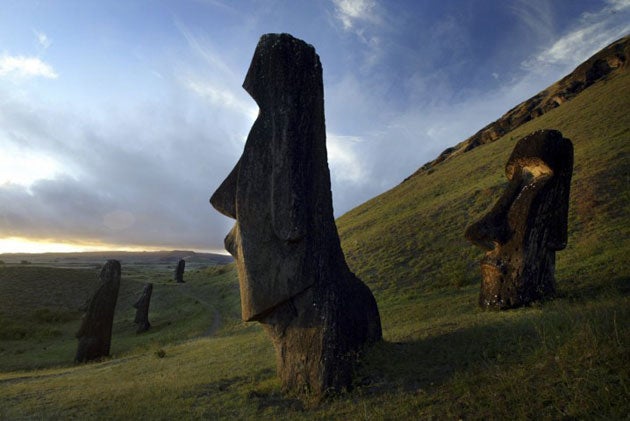Easter Island statue to make a pilgrimage to Paris
Moai has a mission to reform the conscience of humanity, say islanders

Your support helps us to tell the story
From reproductive rights to climate change to Big Tech, The Independent is on the ground when the story is developing. Whether it's investigating the financials of Elon Musk's pro-Trump PAC or producing our latest documentary, 'The A Word', which shines a light on the American women fighting for reproductive rights, we know how important it is to parse out the facts from the messaging.
At such a critical moment in US history, we need reporters on the ground. Your donation allows us to keep sending journalists to speak to both sides of the story.
The Independent is trusted by Americans across the entire political spectrum. And unlike many other quality news outlets, we choose not to lock Americans out of our reporting and analysis with paywalls. We believe quality journalism should be available to everyone, paid for by those who can afford it.
Your support makes all the difference.An unusually large tourist will visit Paris in 2010. One of the vast statues of elongated human heads and torsos from Easter Island in the Pacific has "expressed the wish" to visit the French capital to preach – silently – against Western materialism.
The statue has let it be known to the island's leaders that it wanted to make the pilgrimage, the French newspaper Le Figaro reported yesterday. Two islanders, including the governor's nephew, have made a preparatory visit and concluded that one of the statues or moais, which range up to 30ft high and 90 tons in weight, should stand in the middle of the Tuileries gardens, halfway between the Louvre and the Place de la Concorde.
"Everyone on the island knows that a moai is going to Paris," Edgard Hedreveri, the Easter Island tourism director, told Le Figaro. "It is going to find a platform in Paris to spread spiritual energy which will change the conscience of humanity. It is going to transform the materialistic conscience of the world into something more humane."
The nearly 10,000-mile journey to Paris from Easter Island in the Pacific Ocean, the world's most isolated inhabited island, will be organised by an Italian foundation. The cost of the anti-materialist pilgrimage will be covered – somewhat inappropriately – by the French luxury goods company Louis Vuitton Moët Hennessy (LVMH). There are almost 900 Easter Island statues, carved from compressed volcanic ash between 400 AD and the early 1700s. Although other statues have been stolen or removed to museums, this will be the first time one has been sent on a spiritual journey by the island's government.
Mr Hereveri said the disappearance of the original Easter Island culture, possibly as a result of a man-made ecological calamity, had universal lessons for the planet. "A moai is not just a lump of stone," he said. "It's a connection [with the past]. We will show the world that, by destroying nature, mankind destroys itself. The history of Easter Island is the history of humanity."
He and another island delegate, Pedro Edmonds Paoa, nephew of the governor, toured Paris this year. "With the help of our ancestors, we were searching for the right place for the moai," M. Hereveri said. "In the Tuileries, I knew this was the spot where it [the statue] wanted to stand. A strong current of energy passes through that place."
The particular moai has not yet been chosen by the island's 4,900 inhabitants. It will make the journey to France by sea, then, probably, up the river Seine by barge. Mystery still surrounds the Easter Island statues and the reasons for the disappearance of the elaborate culture which produced them. One theory is that the island's forests were destroyed to create wooden sledges to haul the statues more than 10 miles from volcanic hills to the shore. The resulting ecological calamity produced a revolt and many of the statues were pushed over or destroyed.
Research at an exhibition in Paris (open until March) presents a different story. The Easter Islanders were a "great people" who fell victim to a drought in the southern hemisphere halfway through the 17th century, say the French archaeologists Michel and Catherine Orliac.
Join our commenting forum
Join thought-provoking conversations, follow other Independent readers and see their replies
Comments